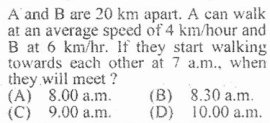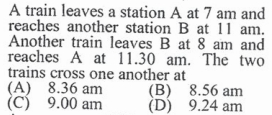 For Daily Job Alert For Daily Job Alert |
Join Our Whats App Channel |
 For Free Study Material For Free Study Material |
Join Our Telegram Channel |
Time and distance is a very easy topic and has limited variety of questions. I will take up questions from each variety and will solve them with shortest method possible.
Let the distance travelled on foot be X km. Then distance travelled on bicycle will be Rs. (80 – X)
X/8 + (80 – X)/16 = 7
After forming this equation, don’t solve it for X. Just observe, X/8 denotes that X is a multiple of 8 (although you can’t be 100% sure, but SSC generally likes whole numbers). That means answer is either 32 km or 48 km. Put X = 32 km in the equation and check if it satisfies the equation. It does!
Answer : (A)
This is a commonly asked question. Just remember –
Time taken to cross a telephone pole = Time taken by the train to cover a distance equal to its length
Speed = 54 km/hr = 54 * 5/18 m/sec = 15 m/sec
Time taken by the train to cover a distance equal to its length = 300/15 = 20 sec
Answer : (A)
If two objects A and B are moving at a given speed and we are asked “when will A overtake B” or “When will the police catch the thief”, we use the concept of Relative Velocity. It’s very simple
When the objects are moving in opposite direction, Relative velocity = Speed of A + Speed of B
When the objects are moving in the same direction, Relative velocity = Speed of A – Speed of B
Let the length of each train be L metres.
Here, the trains are moving in the same direction, hence relative velocity = Speed of train A – Speed of Train B = 10 km/hr = 10 * 5/18 m/sec = 25/9 m/sec
We know, Distance = Speed * Time
Here, Distance = Sum of the length of both the trains, i.e., 2L
Speed = Relative velocity
Time = Time taken by the faster train to overtake the slower train
So, 2L = 36 * 25/9
L = 50 m
Answer : (A)
This question is similar to Q. No. 2. We just have to replace the Speed of the train, with Relative Velocity.
Let the length of the fast train be L.
Trains are running in the same direction, hence Relative Velocity = 40 – 20 = 20 km/hr = 50/9 m/sec
L = 50/9 * 5 = 250/9 metres
Answer : (C)
This question is similar to the above question. But it has a twist! The two trains are not moving at the same time. First train is starting at 7 am, while second train is starting at 8 am.
Method 1 (Relative Velocity)
Remember! To apply the relative velocity formula in such questions, we will first have to make the trains move at the same time. How?
Let the distance between the trains be X km
The first train takes 4 hours (7 am to 11 am) to move from A to B
Hence speed of the first train = X/4
The second train takes 3.5 hours (8 am to 11:30 am) to move from B to A
Hence speed of the second train = X/3.5
From 7 am to 8 am (1 hour), only the first train is moving. Distance travelled by the first train in 1 hour = X/4 * 1 = X/4
Distance left between the two trains = X – X/4 = (3/4)X
Relative velocity of the trains = X/4 + X/3.5
Time taken by the trains to cross one another = (Distance between them) / (Relative velocity)
= (3/4)X / (X/4 + X/3.5)
= 1.40 hours
= 1 hour 24 minutes
So the trains will cross one another at 8 am + 1 hr 24 min = 9 : 24 am
Answer (D)
Method 2 (Equate the distance)
Let the trains cross each other in t hours
First train starts early, so it will travel for complete t hours. But second train starts 1 hour after the first train, so it will travel for (t – 1) hours
Distance travelled by first train in t hours + Distance travelled by second train in (t – 1) hours = X
X/4 * t + X/3.5 * (t – 1) = X
t = 2.4 hours = 2 hours 24 minutes
But this time will be added to 7 a.m.
So, Answer = 7 a.m. + 2 hours 24 minutes = 9:24 a.m.
This question is similar to the above question.
Chor-Sipahi questions are best tackled with Relative Velocity.
Relative Velocity of the Thief and the Owner = 50 – 40 = 10 km/hr
Distance travelled by the thief in half an hour (from 1:30 p.m. to 2 p.m.) = 0.5 * 40 = 20 km
Now the distance between the owner and the thief is 20 km.
So time taken to catch the thief = Distance between them / Relative velocity = 20/10 = 2 hours
He will catch the thief at 2 p.m. + 2 hours = 4 p.m.
Answer : (A)
Method 1 (Relative velocity)
Let P and Q meet in t hours
Distance travelled by P in t hours = 20t (because the speed of P is 20 km/hr)
Distance travelled by Q in t hours = 30t (because the speed of Q is 30 km/hr)
Given, 30t – 20t = 36 km
or t = 3.6 hours
So P and Q meet after 3.6 hours
Relative velocity of P and Q = 20 + 30 = 50 km/hr
Distance between the two places = Time taken by P and Q to meet * Relative velocity = 50 * 3.6 = 180 km
Answer : (A)
Method 2
Let P and Q meet at point M. P has to travel X km to reach M and Q has to travel Y km.
Time taken by P to reach M = Time taken by Q to reach M
X/20 = Y/30
X/Y = 2/3
Given, Y – X = 36 km
Divide the whole equation with Y
1 – X/Y = 36/Y
1 – 2/3 = 36/Y [Put X/Y = 2/3]
Y = 108 km
Hence X = Y – 36 = 72 km
Distance between the two places = X + Y = 108 + 72 km = 180 km
Answer : (A)
If you have any doubt in this article, please drop a comment.
Keep reading 🙂





















